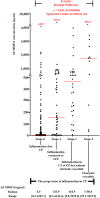The Relationship Among Intra-Amniotic Inflammatory Response, The Progression of Inflammation in Chorionic Plate and Early-Onset Neonatal Sepsis
- PMID: 33996674
- PMCID: PMC8116513
- DOI: 10.3389/fped.2021.582472
The Relationship Among Intra-Amniotic Inflammatory Response, The Progression of Inflammation in Chorionic Plate and Early-Onset Neonatal Sepsis
Abstract
Background: The chorionic plate (CP) has been denigrated by the well-known route of the extraplacental membranes from the decidua parietalis through the chorion to the amnion in the progression of ascending intrauterine infection among preterm births (PTBs). However, considering previous studies reporting the relationship among intra-amniotic inflammatory response (IAIR), the progression of inflammation in extraplacental membranes and early-onset neonatal sepsis (EONS), and the anatomic connection between extraplacental membranes and CP, there is a good chance that IAIR would be more likely and severe according to the progression of inflammation in CP, and this progression of inflammation in CP would be associated with a significant increase in EONS in neonates delivered due to either PTL or preterm-PROM. Unfortunately, there is no information about the relationship among IAIR, the progression of inflammation in CP, and EONS among spontaneous PTBs. The objective of the current study is to examine this issue. Method: The study population included 309 singleton pregnant women-delivered preterm neonates with the following conditions: (1) gestational age (GA) at delivery: 20.0~36.9 weeks; (2) spontaneous PTBs: PTL (151 cases) or preterm-PROM (158 cases); (3) available results of placental histologic examination; (4) without congenital anomaly; and (5) delivery within 60 h of amniocentesis. We examined IAIR, and the frequency of intra-amniotic inflammation (IAI) and EONS according to the progression of inflammation in CP [i.e., stage-0, inflammation-free CP; stage-1, inflammation restricted to subchorionic fibrin (SCF); stage-2, inflammation in connective tissue (CT) of CP but without chorionic vasculitis; and stage-3, chorionic vasculitis]. IAIR was determined by amniotic fluid (AF) matrix metalloproteinase-8 (MMP-8) concentration (ng/ml), and IAI was defined as an elevated AF MMP-8 concentration (≥23 ng/ml). EONS included either suspected or proven EONS. Results: (1) Each stage (stage-0 to stage-3) was present in 69.3% (214/309), 15.9% (49/309), 11.0% (34/309), and 3.9% (12/309) of the study population. (2) AF MMP-8 concentrations continuously elevated according to the progression of inflammation in CP [stage-0 vs. stage-1 vs. stage-2 vs. stage-3; median (ng/ml), range (ng/ml); 6.0 (0.3-4202.7) vs. 153.9 (0.3-6142.6) vs. 464.9 (5.8-3929.0) vs. 1,780.4 (35.1-5019.5); Kruskal-Wallis test, P < 0.001 and Spearman's rank-correlation test, P < 0.000001, r = 0.553]. (3) Moreover, the frequency of IAI and EONS gradually increased with the progression of inflammation in CP [stage-0 vs. stage-1 vs. stage-2 vs. stage-3; IAI, 30.5% (64/210) vs. 70.2% (33/47) vs. 96.7% (29/30) vs. 100% (12/12); EONS, 3.5% (7/200) vs. 25.5% (12/47) vs. 32.3% (10/31) vs. 40.0% (4/10); each for Pearson's chi-square test, P < 0.000001 and linear-by-linear association, P < 0.000001]. (4) Of note, multiple logistic regression analysis demonstrated that a more advanced stage in the progression of inflammation within CP was associated with a higher odds ratio (OR) for EONS [stage-1 vs. stage-2 vs. stage-3; OR, 7.215, 95% confidence-interval (CI) (2.177-23.908) vs. OR, 10.705, 95% CI (2.613-43.849) vs. OR, 27.189, 95% CI (2.557-289.124)] compared with stage-0 even after the adjustment for potential confounding variables. Conclusion: IAIR is more likely and severe according to the progression of inflammation in CP, and this progression of inflammation in CP is an independent risk factor for EONS in spontaneous PTBs. This finding suggests that CP may be another playground for the progression of ascending intrauterine infection in addition to extraplacental membranes, and the progression of inflammation in CP may be used for the prediction of EONS in spontaneous PTBs.
Keywords: ascending intra-uterine infection; chorionic plate inflammation; early-onset neonatal sepsis; intra-amniotic inflammatory response; preterm birth.
Copyright © 2021 Moon, Oh, Park, Park and Jun.
Conflict of interest statement
The authors declare that the research was conducted in the absence of any commercial or financial relationships that could be construed as a potential conflict of interest.
Figures



Similar articles
-
The relationship among the progression of inflammation in umbilical cord, fetal inflammatory response, early-onset neonatal sepsis, and chorioamnionitis.PLoS One. 2019 Nov 19;14(11):e0225328. doi: 10.1371/journal.pone.0225328. eCollection 2019. PLoS One. 2019. PMID: 31743377 Free PMC article.
-
Preterm Labor and Preterm-PROM at a Lower Gestational Age Are Associated with a Longer Latency-to-Delivery Even in Patients with the Same Intensity of Intra-Amniotic Inflammation: "Carroll-Model" Revisited.Life (Basel). 2022 Aug 27;12(9):1329. doi: 10.3390/life12091329. Life (Basel). 2022. PMID: 36143366 Free PMC article.
-
Fetal inflammatory response is positively correlated with the progress of inflammation in chorionic plate.Placenta. 2020 Aug;97:6-17. doi: 10.1016/j.placenta.2020.05.010. Epub 2020 May 30. Placenta. 2020. PMID: 32792065
-
Reliability of Interleukin-6 Alone and in Combination for Diagnosis of Early Onset Neonatal Sepsis: Systematic Review.Front Pediatr. 2022 Mar 23;10:840778. doi: 10.3389/fped.2022.840778. eCollection 2022. Front Pediatr. 2022. PMID: 35402358 Free PMC article.
-
Advances in medical diagnosis of intra-amniotic infection.Expert Opin Med Diagn. 2013 Jan;7(1):5-16. doi: 10.1517/17530059.2012.709232. Epub 2012 Aug 17. Expert Opin Med Diagn. 2013. PMID: 23530840 Free PMC article. Review.
Cited by
-
Single-cell analysis of the decidua unveils the mechanism of anti-inflammatory exosomes for chorioamnionitis in nonhuman primates.Sci Adv. 2025 Jul 4;11(27):eadp0467. doi: 10.1126/sciadv.adp0467. Epub 2025 Jul 2. Sci Adv. 2025. PMID: 40601753 Free PMC article.
-
The Inflammatory Milieu of Amniotic Fluid Increases with Chorio-Deciduitis Grade in Inflammation-Restricted to Choriodecidua, but Not Amnionitis, of Extra-Placental Membranes.J Clin Med. 2021 Jul 8;10(14):3041. doi: 10.3390/jcm10143041. J Clin Med. 2021. PMID: 34300208 Free PMC article.
References
-
- Park CW, Park JS, Moon KC, Jun JK, Yoon BH. Preterm labor and preterm premature rupture of membranes have a different pattern in the involved compartments of acute histologoic chorioamnionitis and/or funisitis: patho-physiologic implication related to different clinical manifestations. Pathol Int. (2016) 66:325-32. 10.1111/pin.12412 - DOI - PubMed
LinkOut - more resources
Full Text Sources
Other Literature Sources
Miscellaneous

